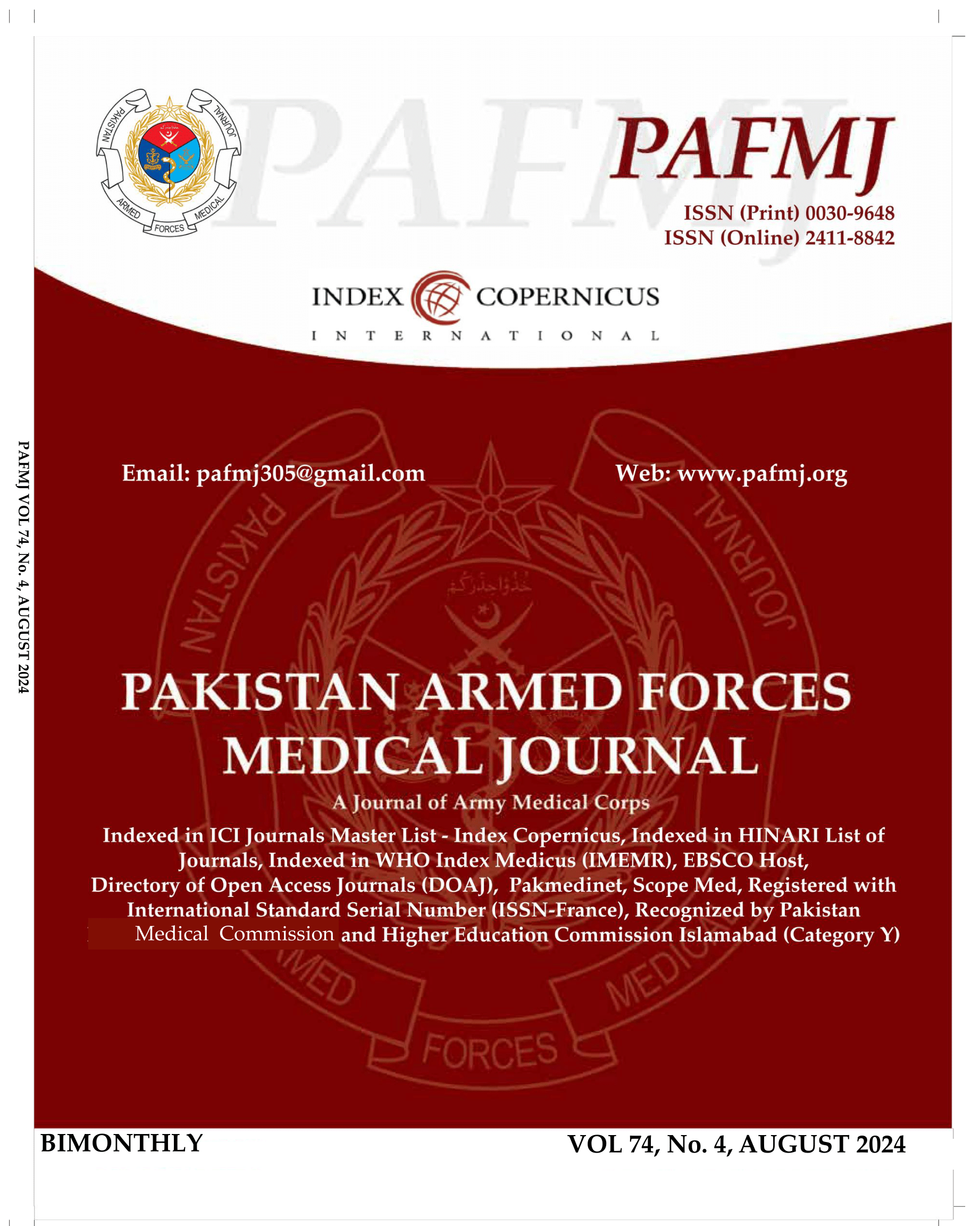Risk Factors for Early Post-Operative Arrhythmias in Children Undergoing Congenital Heart Surgeries
DOI:
https://doi.org/10.51253/pafmj.v74i4.7894Keywords:
Arrhythmia, cardiopulmonary bypass, inotropic score, left ventricular ejection fractionAbstract
Objective: To determine the risk factors for early post-operative arrhythmias in children undergoing congenital heart surgeries at a tertiary care hospital.
Study Design: Prospective longitudinal study.
Place and Duration of Study: National Institute of Cardiovascular Disease, Karachi Pakistan, from Jan to Jul 2020.
Methodology: We included 143 patients of both genders undergoing open heart surgery for congenital heart diseases. We noted all patients' pre-operative, intra-operative, and post-operative clinical characteristics. Patients were monitored in the pediatric cardiac intensive care unit. We analyzed the development of postoperative arrhythmias and the factors associated with them.
Results: In 143 patients, the mean age at the time of surgery was 7.52±6.0 years. There were 83(58.0%) male patients. Tetralogy of Fallot was the most common type of congenital heart disease noted in 57(39.0%) patients. The mean cardiopulmonary bypass time was 83.9±25.5 minutes, while the mean aortic cross-clamp time was 58.1±21.9 minutes. Post-operatively, arrhythmia was observed in 39(27.3%) children. Intra-operative arrhythmias (p<0.001), prolonged cardiopulmonary bypass time (p=0.008), prolonged cross-clamp time (p<0.001), higher inotropic score (p<0.001) and lower post-operative left ventricular ejection fraction (p=0.001) were significantly associated with arrhythmias.
Conclusion: The post-operative arrhythmias among patients undergoing congenital heart surgeries was high. Intra-operative arrhythmias, prolonged cardiopulmonary bypass time, decreased post-operative left ventricular ejection fraction, and high inotropic score were significant risk factors for the development of post-operative arrhythmias.
Downloads
References
Hoque KZ, Sultana AT, Mia M. Early postoperative arrhythmias after paediatric cardiac surgery. Delta Med Coll J 2018; 6(1): 22-28.
https://doi.org/10.3329/dmcj.v6i1.35964
Sahu MK, Das A, Siddharth B, Talwar S, Singh SP, Abraham A, et al. Arrhythmias in children in early postoperative period after cardiac surgery. World J Pediatr Congenit Heart Surg 2018; 9(1): 38-46. https://doi.org/10.1177/2150135117737687
Kabbani MS, Al Taweel H, Kabbani N, Al Ghamdi S. Critical arrhythmia in postoperative cardiac children: Recognition and management. Avicenna J Med 2017; 7(3): 88-95.
https://doi.org/10.4103/ajm.AJM_14_17
Talwar S, Patel K, Juneja R, Choudhary SK, Airan B. Early postoperative arrhythmias after pediatric cardiac surgery. Asian Cardiovasc Thorac Ann 2015; 23(7): 795-801.
https://doi.org/10.1177/0218492315585457
Jain A, Alam S, Viralam SK, Sharique T, Kapoor S. Incidence, risk factors, and outcome of cardiac arrhythmia postcardiac surgery in children. Heart Views 2019; 20(2): 47-52.
https://doi.org/10.4103/HEARTVIEWS.HEARTVIEWS_88_18
Chelo D, Ateba NA, Tchoumi JCT, Nonga BN. Early post-operative arrhythmias after cardiac surgery in children at Shisong Cardiac Center, Cameroon. Health Sci Dis 2015; 16(2): 1-6.
Hanash CR, Crosson JE. Emergency diagnosis and management of pediatric arrhythmias. J Emerg Trauma Shock 2010; 3(3): 251-260. https://doi.org/10.4103/0974-2700.66525
Peretto G, Durante A, Limite LR, Cianflone D. Postoperative arrhythmias after cardiac surgery: incidence, risk factors, and therapeutic management. Cardiol Res Pract 2014; 2014: 615987.
https://doi.org/10.1155/2014/615987
Delaney JW, Moltedo JM, Dziura JD, Kopf GS, Snyder CS. Early postoperative arrhythmias after pediatric cardiac surgery. J Thorac Cardiovasc Surg 2006; 131(6): 1296-1300.
https://doi.org/10.1016/j.jtcvs.2006.02.010
Grosse-Wortmann L, Kreitz S, Grabitz RG, Vazquez-Jimenez JF, Messmer BJ, von Bernuth G, et al. Prevalence of and risk factors for perioperative arrhythmias in neonates and children after cardiopulmonary bypass: continuous holter monitoring before and for three days after surgery. J Cardiothorac Surg 2010; 5(1): 1-8. https://doi.org/10.1186/1749-8090-5-85
Satur CM, Stubington SR, Jennings A, Newton K, Martin PG, Gebitekin C, et al. Magnesium flux during and after open heart operations in children. Ann Thorac Surg 1995; 59(4): 921-927.
https://doi.org/10.1016/0003-4975(95)00049-q
Dorman BH, Sade RM, Burnette JS, Wiles HB, Pinosky ML, Reeves ST, et al. Magnesium supplementation in the prevention of arrhythmias in pediatric patients undergoing surgery for congenital heart defects. Am Heart J 2000; 139(3): 522-528.
https://doi.org/10.1016/s0002-8703(00)90097-8
Kamel YH, Sewielam M. Arrhythmias as early post operative complications of cardiac surgery in children at cairo university. Pion Egypt Cardiol 2009; 61: 193-199.
https://doi.org/10.3923/JMS.2009.126.132
Yildirim SV, Tokel K, Saygili B, Varan B. The incidence and risk factors of arrhythmias in the early period after cardiac surgery in pediatric patients. Turk J Pediatr 2008; 50(6): 549-553.
Valsangiacomo E, Schmid ER, Schüpbach RW, Schmidlin D, Molinari L, Waldvogel K, et al. Early postoperative arrhythmias after cardiac operation in children. Ann Thorac Surg. 2002; 74(3): 792-796.
https://doi.org/10.1016/s0003-4975(02)03786-4
Dietl CA, Cazzaniga ME, Dubner SJ, Pérez-Baliño NA, Torres AR, Favaloro RG. Life-threatening arrhythmias and RV dysfunction after surgical repair of tetralogy of Fallot. Comparison between transventricular and transatrial approaches. Circulation 1994; 90(5 Pt 2): II7-II12.
Parry AJ, McElhinney DB, Kung GC, Reddy VM, Brook MM, Hanley FL. et al. Elective primary repair of acyanotic tetralogy of Fallot in early infancy: overall outcome and impact on the pulmonary valve. J Am Coll Cardiol 2000; 36(7): 2279- 2283.
https://doi.org/10.1016/s0735-1097(00)00989-x
Cools E, Missant C. Junctional ectopic tachycardia after congenital heart surgery. Acta Anaesthesiol Belg 2014; 65(1): 8.
Jacobs JP, Jacobs ML, Maruszewski B, Lacour-Gayet FG, Clarke DR, Tchervenkov CI, et al. Current status of the European Association for Cardio-Thoracic Surgery and the Society of Thoracic Surgeons Congenital Heart Surgery Database. Ann Thorac Surg 2005; 80(6): 2278-2283.
https://doi.org/10.1016/j.athoracsur.2005.05.107
Rekawek J, Kansy A, Miszczak-Knecht M, Manowska M, Bieganowska K, Brzezinska-Paszke M, et al. Risk factors for cardiac arrhythmias in children with congenital heart disease after surgical intervention in the early postoperative period. J Thorac Cardiovasc Surg 2007; 133(4): 900-904.
https://doi.org/10.1016/j.jtcvs.2006.12.011
Batra AS, Chun DS, Johnson TR, Maldonado EM, Kashyap BA, Maiers J, et al. A prospective analysis of the incidence and risk factors associated with junctional ectopic tachycardia following surgery for congenital heart disease. Pediatr Cardiol 2006; 27(1): 51-55.
Downloads
Published
Issue
Section
License
Copyright (c) 2024 Mujeeb ur Rehman, Muhammad Asif Khan, Raam Chand, Shahnawaz Sathio, Abdul Sattar Shaikh, Fatima Amin, Najma Patel

This work is licensed under a Creative Commons Attribution-NonCommercial 4.0 International License.















